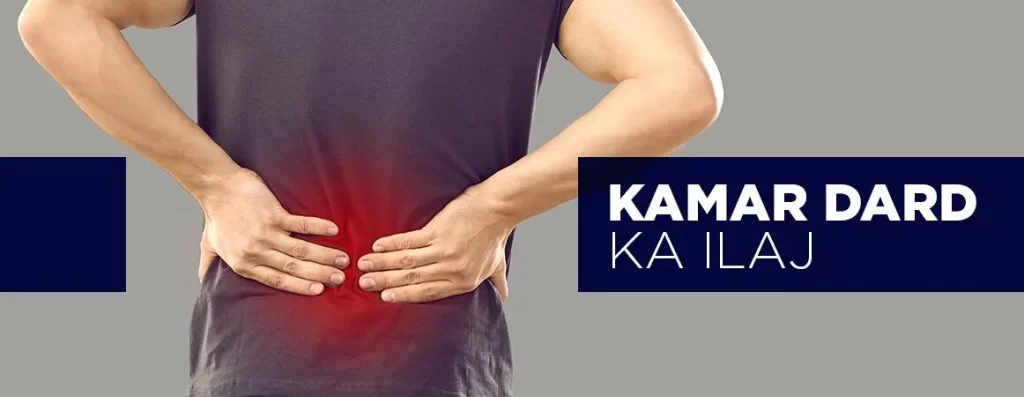Kamar Dard ka Ilaj
Understanding Back Pain
Back pain can originate from a variety of sources, including the muscles, nerves, bones, and joints in the spine. It can affect the lower back, mid-back, or upper back and may sometimes radiate down the legs. Acute pain lasts a few days to a few weeks, while chronic pain lasts three months or more.
Back Pain Causes
Identifying back pain causes is essential for effective treatment. Common causes include:
- Muscle or Ligament Strain: Lifting heavy objects, sudden awkward movements, or repetitive motions can strain muscles and ligaments, leading to pain.
- Herniated Discs: Damage to a spine disc can cause it to bulge or burst, putting pressure on neighboring nerves and producing pain.
- Arthritis: Conditions like osteoarthritis can affect the spine, leading to narrowing of the space around the spinal cord (spinal stenosis) and resulting in back pain.
- Skeletal Irregularities: Conditions such as scoliosis (curvature of the spine) can contribute to back pain by altering the normal alignment of the spine.
- Infections or Tumors: Although less common, infections of the spine or tumors can cause significant back pain and require immediate medical attention.
- Back Spasms: Muscle spasms in the back, known as back spasm (chuk ka dard), can occur due to overuse, injury, or underlying conditions, leading to sudden and intense pain.
Back Pain Symptoms
Back pain symptoms can vary widely depending on the underlying cause. Common symptoms include:
- Dull or sharp pain in the back that may worsen with movement or certain positions
- Muscle stiffness and reduced flexibility
- Pain that radiates down the legs
- Numbness or tingling in the extremities
- Having trouble keeping a normal posture or standing up straight
Kamar Ke Dard Ka Ilaj
When it comes to back pain treatment, various options are available depending on the severity and cause of the pain. Here are some effective approaches:
- Rest and Activity Modification: Initially, it may be helpful to rest for a short period. However, prolonged inactivity can worsen back pain. Gentle activities like walking or stretching can aid recovery.
- Physical Therapy: A physical therapist can create a customized training regimen to increase flexibility, strengthen the muscles that support the spine, and encourage better posture.
- Medications: Over-the-counter pain relievers, such as nonsteroidal anti-inflammatory drugs (NSAIDs) like ibuprofen or naproxen, can help reduce pain and inflammation. In more severe cases, a doctor may prescribe stronger medications or muscle relaxants for back spasm relief.
- Heat and Cold Therapy: Relief may be obtained by applying cold or hot packs to the afflicted area. While heat therapy increases blood flow and eases tense muscles, cold therapy aids in reducing inflammation.
- Chiropractic Care: Chiropractors use hands-on spinal manipulation to relieve back pain and improve alignment. This treatment can be beneficial for certain types of back pain, particularly those related to musculoskeletal issues.
- Alternative Therapies: Some individuals find relief from complementary therapies such as acupuncture, massage, or yoga. These approaches can help reduce stress, promote relaxation, and alleviate pain.
- Surgical Options: In cases where conservative treatments fail to provide relief, surgical options may be considered. Procedures such as discectomy or spinal fusion may be appropriate for certain conditions, such as herniated discs or spinal stenosis.
Preventing Back Pain
Prevention is key to avoiding future episodes of back pain. Here are some strategies to consider:
- Maintain a Healthy Weight: Too much weight can put a strain on the back. Maintain a healthy weight by a well-balanced diet and exercise.
- Practice Good Posture: Being mindful of posture while sitting, standing, and lifting can help prevent strain on the back.
- Strengthen Core Muscles: Engaging in exercises that strengthen the abdominal and back muscles can provide support for the spine and reduce the risk of injury.
- Use Proper Lifting Techniques: When lifting heavy objects, bend at the knees and keep the load close to the body to avoid straining the back.
Conclusion
Back pain or including chuk ka dard is a common condition that can significantly impact daily life. Understanding the back pain causes, recognizing back pain symptoms, and exploring various back pain treatment options are essential steps toward effective management. Whether through rest, physical therapy, medications, or lifestyle changes, individuals can find relief and prevent future episodes of back pain.
Post Disclaimer
The information contained in this post is for general information purposes only. The information is provided by "Kamar Dard ka Ilaj "and while we endeavour to keep the information up to date.
Legal Disclaimer
We do not claim to cure any disease which is considered’ incurable ‘ on the basis of scientific facts by modern medicine .The website’s content is not a substitute for direct, personal, professional medical care and diagnosis. None of the medicines mentioned in the posts ,including services mentioned at "medicineguide.us" should be used without clearance from your physician or health care provider.
Testimonials Disclaimer– : Results may vary, and testimonials are not claimed to represent typical results. The testimonials are real, and these patients have been treated with homeopathy treatment from our clinic . However, these results are meant as a showcase of what the best, Medicine can do with their disease contions and should not be taken as average or typical results.


